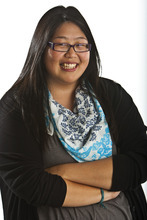This is an archived article that was published on sltrib.com in 2011, and information in the article may be outdated. It is provided only for personal research purposes and may not be reprinted.
University of Utah student Esther Kim is following the path of 20th-century Civil Rights pioneers. She's one of 40 students chosen by the producers of PBS' "American Experience" to get on a bus and retrace the route of the Freedom Riders who fought racism half a century ago.
The re-creation of the ride is meant to engage youth, and are a more diverse group than the 1961 group, who were almost all either black or white. Kim, who's Korean-American, said her relationship with the Civil rights movement is "kind of complicated."
"It's weird because I had never seen Asian-Americans within this specific context," she said. "I want to feel connected to the Civil Rights movement, but I don't see myself reflected in it. So for me, part of this bus ride will be kind of reconciling where I belong within the larger social-justice movement."
—
Next-gen freedom riders • Kim and the other 39 riders from 30 states and the District of Columbia departed from Washington, D.C. on May 8 on a route that takes them through Virginia, North Carolina, South Carolina, Georgia, Alabama, Tennessee, Mississippi and Louisiana. They're being joined by some of the original Freedom Riders and political figures like John Seigenthaler, who was the administrative assistant to then-Attorney General Robert F. Kennedy in 1961.
Their bus is a "moving digital classroom," according to "American Experience" executive producer Mark Samels, which will stop along the way and engage students in a history lesson about the original riders.
In 1961, more than 400 black and white Americans — most of them college students — traveled together on buses and trains through the Deep South to challenge Jim Crow laws. Many were arrested; some endured savage beatings; all feared for their lives.
Despite the danger, the riders embraced nonviolence. "To allow violence to defeat nonviolence would have been the end of the hope of the generations before us as well as our own generation," said C.T. Vivian, an original freedom rider who was then on Martin Luther King's executive staff. "The feeling was that this is exactly what we'd been waiting for — a chance to challenge evil in its own hometown. My wife and I talked and we both knew that, live or die, we were doing the best thing for our children."
—
Singing freedom songs • They were determined not to surrender, even when racists set fire to one of the buses.
"Well, I knew that if the Freedom Ride had stopped right then, we would have to have gotten many, many people killed before we were able to have a movement about anything — voting rights, desegregating public facilities, or anything — because the message would have been sent that you could stop a campaign by inflicting massive violence," said Diane Nash, a member of the Student Non-violent Coordinating Committee and one of the organizers of the rides.
"Freedom Riders" has already shown an ability to connect with young viewers, when it screened in Salt Lake City during the 2010 Sundance Film Festival to a group of Utah high school students who "just went wild for the film," said Stanley Nelson, the documentary's writer/producer/director. "They were clapping along with the closing credits. And we had a couple of Freedom Riders there … singing freedom songs with the high school students. It was just an incredible experience."
Kim, a Skyline High graduate who's double-majoring in gender studies and sociology with a minor in Asian-America studies, is also an activist. "That's what I'm passionate about," she said. At the U., she serves as social justice and awareness week chair for the Asian American Student Association. She's also the co-chair of the student group Queer Students of Color, which works to "make a space at the university for students who are kind of on the margins of the margins."
—
From appreciating history to activism • Others in her generation appear passionate about these issues, too. In fact, the inspiration for the film "Freedom Riders" came from Samels' 22-year-old daughter, who was taking a class from an author who wrote a book about the movement. She urged her father to explore the subject in film.
"It was a story that I thought would resonate with my generation," Samels said. "My daughter was evidence that it could resonate with a younger generation."
Joan Mulholland, who was just 19 when she was a Freedom Rider, said she can envision contemporary youth taking up activism.
"We were considered sort of pampered airheads" who didn't understand what it was like to go through the Depression and World War II, she said. "And [the movement] caught fire. I think it could happen again. We can't tell what it will be about, but something will spark people's sense of urgency. And maybe they can learn from the way we did things, and the ideas that we had can give them some clues on how to deal with whatever they decide to face."
Twitter: @ScottDPierce
Facebook.com/tribremix —
A contemporary take on the 'Freedom Riders'
P "Freedom Riders," a two-hour "American Experience" documentary, premieres Monday, May 16, at 7 p.m. on KUED-Ch. 7. It will be followed by the locally produced "Utah's Freedom Riders," about the fight for racial equality in the Beehive state, at 9 p.m.; and "Navigating Freedom: A Utah Youth Perspective," which features four short films, at 9:30 p.m.



